» posted on Wednesday, September 5th, 2012 by Linda Lou Burton
A Capital Drive
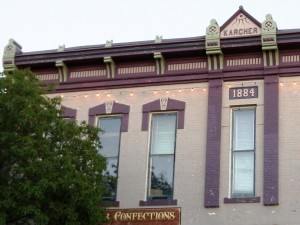 Linda Burton posting from Pierre, South Dakota – Tony handed me three brochures — the Pierre Historic Homes Driving Tour, Pierre Hill Residential Historic District, and Historic Pierre Street. “Now you’re set,” he said. I’d been noticing the shady tree-lined streets in town; you know, those old-fashioned kinds of neighborhoods with sidewalks for leisurely afternoon strolls. Now I wanted to learn a little about the people who settled Pierre, and the houses they built. I knew the town was bustling in the early 1880’s in Dakota Territory days. So, I’d stopped at the Visitor Center for details. I decided to focus on the houses listed on the National Register of Historic Places first. To my surprise, the first house starred was built after WWII! It was squared-off and modern looking, built of shiny panels. Check the brochure: the panels are porcelain enamel and are outside and in; the house was built by Lustron Corporation to help ease the housing shortage after the war; there are still 38 of them in the state. Unusual. Next on the list, a sprawling three-story mansion on Erskine; built in 1885, it has its original parquet floors. Awesome. At South Washington I park the car and get out; it’s picture-taking time.
Linda Burton posting from Pierre, South Dakota – Tony handed me three brochures — the Pierre Historic Homes Driving Tour, Pierre Hill Residential Historic District, and Historic Pierre Street. “Now you’re set,” he said. I’d been noticing the shady tree-lined streets in town; you know, those old-fashioned kinds of neighborhoods with sidewalks for leisurely afternoon strolls. Now I wanted to learn a little about the people who settled Pierre, and the houses they built. I knew the town was bustling in the early 1880’s in Dakota Territory days. So, I’d stopped at the Visitor Center for details. I decided to focus on the houses listed on the National Register of Historic Places first. To my surprise, the first house starred was built after WWII! It was squared-off and modern looking, built of shiny panels. Check the brochure: the panels are porcelain enamel and are outside and in; the house was built by Lustron Corporation to help ease the housing shortage after the war; there are still 38 of them in the state. Unusual. Next on the list, a sprawling three-story mansion on Erskine; built in 1885, it has its original parquet floors. Awesome. At South Washington I park the car and get out; it’s picture-taking time.
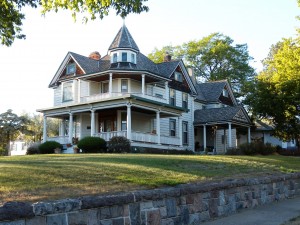 The gorgeous corner house on the hill was built in 1885, says the brochure; it’s Queen Anne style. A wrap-around porch, an upstairs porch, a turret; it faces west; I’ll bet there is a stunning river view. Coe Crawford lived here until 1896; he served as governor and US Senator. Around on Nicollet a sedate Dutch Colonial faces the capitol; trees frame the view; flowers line the walk; its spacious open porch is supported by four Doric columns resting on
The gorgeous corner house on the hill was built in 1885, says the brochure; it’s Queen Anne style. A wrap-around porch, an upstairs porch, a turret; it faces west; I’ll bet there is a stunning river view. Coe Crawford lived here until 1896; he served as governor and US Senator. Around on Nicollet a sedate Dutch Colonial faces the capitol; trees frame the view; flowers line the walk; its spacious open porch is supported by four Doric columns resting on 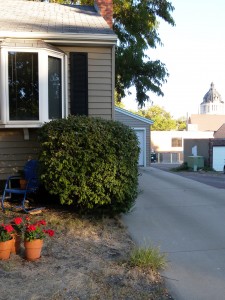 stone foundations. Built in 1904, it has been in the same family since 1925. The prairie-style home on North Highland was built in 1913 by the Hopples; he was mayor from 1924-1939 and owned the Pierre Capital Journal. There’s the house on Euclid that took five years to complete; native stone was used and it was cut by workers brought from Germany. A non-starred house catches my eye; pots of red geraniums sit on the ground beside a blue-steel chair, the capitol dome is visible just over the garage. Variety.
stone foundations. Built in 1904, it has been in the same family since 1925. The prairie-style home on North Highland was built in 1913 by the Hopples; he was mayor from 1924-1939 and owned the Pierre Capital Journal. There’s the house on Euclid that took five years to complete; native stone was used and it was cut by workers brought from Germany. A non-starred house catches my eye; pots of red geraniums sit on the ground beside a blue-steel chair, the capitol dome is visible just over the garage. Variety.
I turn into the Pierre Hill Historic District; it was known simply as “the Hill” between 1900 and 1912; it’s still a prestigious address today. It was convenient, close to the federal building, state capitol, and county courthouse; a handy spot for lawyers, judges and government officials to live. It was considered a “family place” – 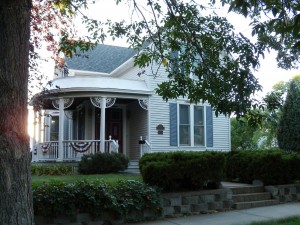 away from saloons and near churches and schools; out of danger of Missouri River flooding that periodically plagued the flats. I park again to walk a bit; two boys on bikes are slowly circling round and talking school; sprinklers rattle gently in the yards. The Queen Anne house on Grand was built in 1892; I’d love to have it for my own; I’d be sitting on that porch right now. Down on Wynoka there is a 1904 Colonial Revival that was first occupied by a Civil
away from saloons and near churches and schools; out of danger of Missouri River flooding that periodically plagued the flats. I park again to walk a bit; two boys on bikes are slowly circling round and talking school; sprinklers rattle gently in the yards. The Queen Anne house on Grand was built in 1892; I’d love to have it for my own; I’d be sitting on that porch right now. Down on Wynoka there is a 1904 Colonial Revival that was first occupied by a Civil  War veteran; Colonel Farr, and his wife Dr Mary Farr, one of the first female doctors in Pierre. The neighborhood was platted by the Chicago and North Western Railroad between 1881 and 1883, according to the brochure; homes were built between 1890 and 1947.
War veteran; Colonel Farr, and his wife Dr Mary Farr, one of the first female doctors in Pierre. The neighborhood was platted by the Chicago and North Western Railroad between 1881 and 1883, according to the brochure; homes were built between 1890 and 1947.
The sun is getting low, I head for the business district. Three large brick buildings – the Hilger, Central, and Karcher Blocks, all built between 1883 and 1884 – made Pierre Street the 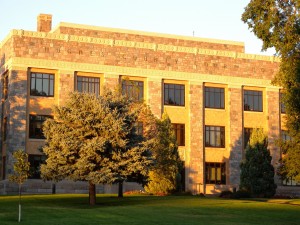 center of the business community back then. There’s a mall on the outskirts of town, as most cities have today; but the downtown core remains much as it was. I stop for pictures of the Hughes County Courthouse, its stone glowing in the setting sun; across the street is what once was the Grand Opera House. A block away the crowd lines up for ice cream at Zesto’s, The Campaign is playing at The State Theater. Down the hill a bench invites a sit; across the street,
center of the business community back then. There’s a mall on the outskirts of town, as most cities have today; but the downtown core remains much as it was. I stop for pictures of the Hughes County Courthouse, its stone glowing in the setting sun; across the street is what once was the Grand Opera House. A block away the crowd lines up for ice cream at Zesto’s, The Campaign is playing at The State Theater. Down the hill a bench invites a sit; across the street,  a bronze statue watches over everything. Kitties sleep on carpet trees behind the window at PAWS, next to Prairie Pages, LLC, a bookstore that is closed for the day. A giant American flag hangs in front of the log-constructed American Legion building; they have picnic tables riverside. The light changes on Sioux and traffic starts to move; I head back to my room, it’s nearly dark.
a bronze statue watches over everything. Kitties sleep on carpet trees behind the window at PAWS, next to Prairie Pages, LLC, a bookstore that is closed for the day. A giant American flag hangs in front of the log-constructed American Legion building; they have picnic tables riverside. The light changes on Sioux and traffic starts to move; I head back to my room, it’s nearly dark.
It was a nice drive, in a nice capital city.
Pierre City http://ci.pierre.sd.us/
Pierre Chamber and Visitors http://www.pierre.org/
Note: Pierre (PEER) is the second smallest capital city; according to the 2010 US Census 13,646 people live here. The racial makeup of the town is 85% white, 11% Native American, 2% Hispanic, and less than 1% each African-American, Asian and other. The town was founded in 1880 opposite Fort Pierre on the Missouri River. It has been the capital city since statehood in 1889, and is almost center of the state.
